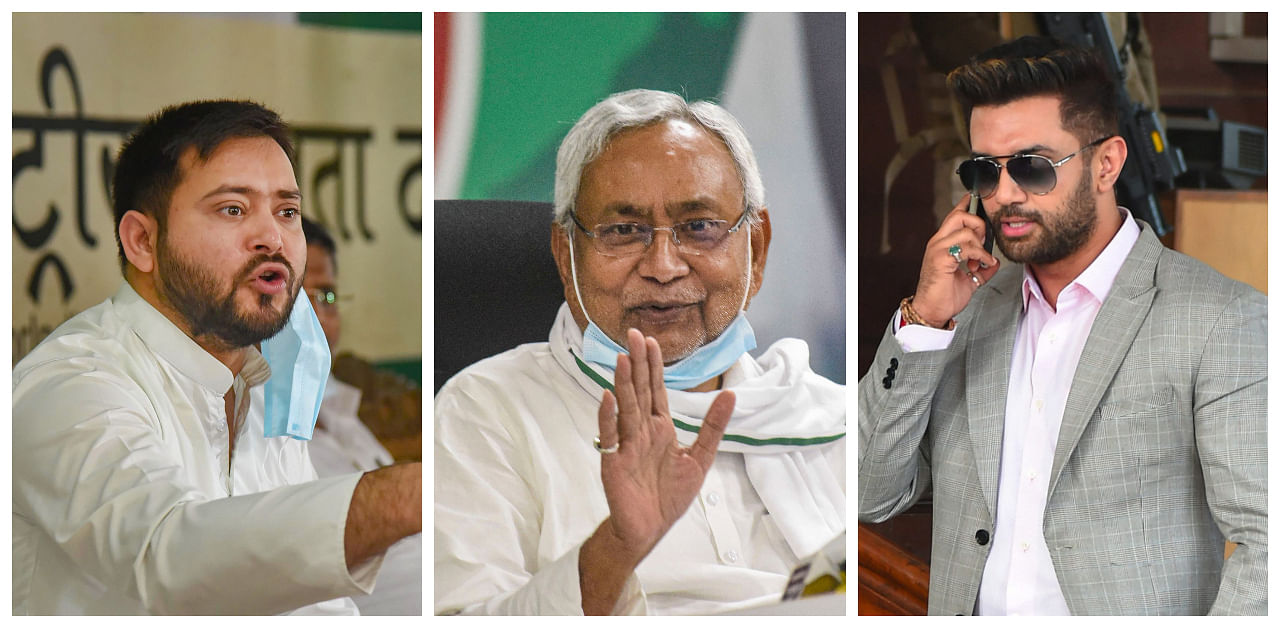
If the 2010 and 2015 assembly elections in Bihar were largely themed around Nitish Kumar and his much-vaunted governance, this year’s polls are expected to be as much of a referendum on his current tenure as CM as an outcome of the state of the alliances that have panned out in unexpected ways. The alliances have not only infused fluidity but spurred active speculation on the post-poll permutations and combinations.
Indeed, commentators believe Bihar could head the Maharashtra way and throw up an unanticipated coalition. Except there’s one factor that is cast in stone: The Congress and the BJP will never join hands. The other cast of players that have the Nitish’s Janata Dal (United) or JD(U) and Tejashwi Yadav’s Rashtriya Janata Dal (RJD are bound to make hard calculations before charting their paths.
At the epicentre of the alliances stands Ram Vilas Paswan’s Lok Janshakti Party (LJP) that virtually passed into the hands of his scion and Lok Sabha MP, Chirag Paswan, who calls the shots in the absence of his father. Paswan senior underwent a heart surgery that ruled him out of the campaign. Chirag’s ambitions to head Bihar, realistically or fancifully, were fuelled by the presence of Tejashwi, Lalu Prasad’s heir, and his lead role.
Legatees in Indian politics rarely take a measure of their intrinsic worth or reckon with the changing mood of people who increasingly demonstrate little patience or tolerance of the heir-apparent and support leaders who earn their stripes on their own, sans political pedigree. Chirag and Tejashwi are convinced that they are destined to mould Bihar’s destiny and their allies, the BJP and Congress, are reconciled to play secondary parts.
It was a combination of ambition, major differences with the JD(U) and a smidgen of ground sense that pushed Chirag to sever ties with Nitish’s party and go independent of the NDA. However, by a sleight of hand, the LJP declared it will not contest against the BJP. On its part, the BJP, while affirming that the polls are being fought under Nitish’s stewardship, has not uttered a word against the Paswans, reinforcing a perception that it does not want to lose the JD (U) and the LJP.
On the other hand, the UPA happily discarded three of its partners, the Rashtriya Lok Samta Party (RLSP), the Hindustani Awam Morcha (Secular) or HAM (S) and the Vikassheel Insaan Party (VIP). All three are confined to small pockets and bring in caste-specific votes. The RLSP has become part of a “third front” that has so far brought together Asaduddin Owaisi’s All India Majlis-e-Ittehadul Muslimeen (AIMIM), the Bahujan Samaj Party (BSP) and the Jan Adhikar Party (JAP), led by Pappu Yadav, a former RJD member.
Incidentally, Pappu Yadav took a lead in actively working among the migrants who returned to Bihar during the national lockdown. His initiative stood out because the CM was ambivalent over getting the returning migrants and devising ways of resettling them in Bihar. The HAM (S) tied up with the JD(U), ostensibly to compensate for the Dalit votes it could lose after the LJP walked out. The VIP is trying to team up with the “third front”. The front is projected to eat into the UPA’s votes and help the NDA tangentially. Bereft of ideological commitment (barring the AIMIM), the other constituents could join the NDA if an opportunity arose after the polls.
Among the players, Nitish is the one who has to defend his turf, answer charges of “bad” governance and possibly suffer the loss of his status as Bihar’s preeminent leader for nearly 15 years. The LJP has announced that Nitish is the prime adversary, a tactic that puts the BJP in a piquant position. Will the BJP defend Nitish against the LJP and risk losing the Paswans by the end of the polls? Or will it calibrate its campaign in a way that neither is offended? Such “clever”—or too clever by half—ploys never work in an election, and not one in a highly politicised state like Bihar, where elections are decided after voters hear out the leaders to the point of deconstructing and analysing every word spoken from the stump.
The BJP’s quandary is because of its dependence on the JD(U) and the LJP for the votes they bring in and more importantly, to dilute its image as an “upper caste” party that isn’t an accurate representation because on its own, the BJP pulls in support from sections of the backward castes and Dalits. But because the upper castes canvass loudly in its support, it has got identified with the Brahmins, Rajputs, Bhumihars and Banias.
The RJD, that struck an alliance with the Congress and the Left spectrum, notably the CPI (M-L), hopes to not only win its core votes but reach out to an enlarged base, principally on Lalu Prasad’s legacy or what remains of it. Lalu, in jail at Ranchi, will skip the elections. The elections are a litmus test of the acceptability and credibility of the leadership the two legatees, Tejashwi and Chirag, have sought to establish. Who among them will be an Uddhav Thackeray in the post-poll scenario has to be seen.
(Radhika Ramaseshan is a Delhi-based political analyst and columnist)
The views expressed above are the author’s own. They do not necessarily reflect the views of DH.